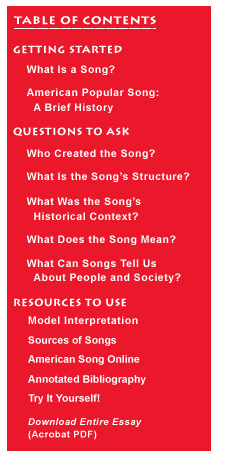talking history | syllabi | students | teachers | puzzle | about us

|
 |
|
Questions about structure are addressed by literary and musical analysis rather than by historical research. What is the metric structure of the text? How many words to a line? How many lines to a stanza? Are lines of the same or different lengths? Do the ends of lines rhyme? If so, what is the rhyme scheme? Are there internal rhymes? Alliteration? Assonance? These are standard tools of literary analysis, particularly the analysis of poems, and they often work quite well for American songs. Additional issues arise having to do with the relation of words and music. Is the song strophic—i.e. does the tune repeat over and over with new words? Or is it through-composed—i.e. neither words nor music repeat? Or does it have a verse-chorus structure, where the tune repeats in the verse with new words, but words and tune both repeat in the chorus? Many American songs rely on a “hook,” a memorable verbal phrase set with a melodic fragment that seems to fit the words like a glove—“My old Kentucky home,” “Take me out to the ball game,” “Someone to watch over me,” “Stand by your man.” The hook often occurs more than once during the song and becomes its most salient feature. You do not need formal musical training to undertake the analysis of a song’s musical aspects. Understanding some aspects of songs does require musical training: for example well-trained musicians can look at a printed score and hear a tune. Those who do not read music, however, can get to the same place quickly by listening several times to a recording, or to a couple of different recordings. As listeners, many of us are familiar with tunes, harmonies, instrumentation and performance styles, even if we don’t have the ready vocabulary to describe these things. You should experiment with musical understanding and your ability to understand music within its musical, as well as historical, context. Even without formal training, most people can identify song as sounding “Irish,” or like a “blues,” or like “military music” and can interpret certain chords as “sad” or “mysterious.” In making those judgments, listeners are picking up important messages in the music itself.
|
|

|
|

